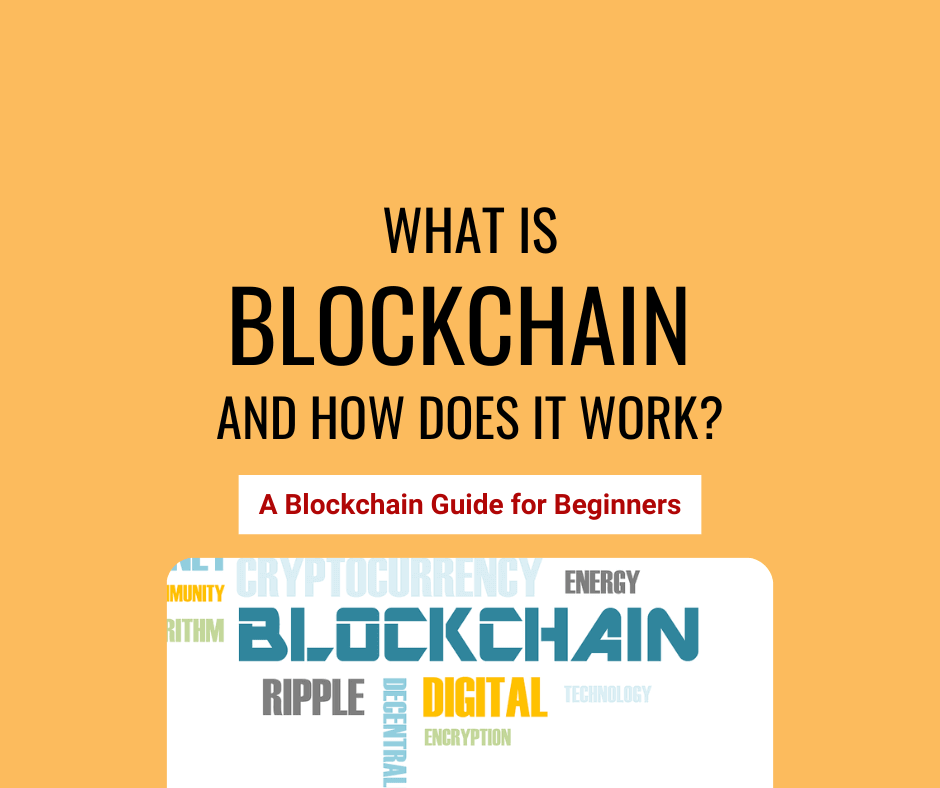Today, we’re diving deep into blockchain – to learn what is blockchain technology and how it works its magic.
Imagine a world where trust isn’t confined to institutions or authorities but is woven into the very fabric of the internet.
Picture a technology so ingenious that it has the potential to disrupt industries, transform businesses, and empower individuals worldwide.
It’s no wonder that blockchain technology has taken the world by storm, captivating the imagination of innovators, investors, and everyday enthusiasts alike.
If you’re ready to explore the marvels of this blockchain phenomenon, to see how it powers cryptocurrencies like Bitcoin and Ethereum, then buckle up as we embark on a journey into the realm of decentralized networks, cryptographic security, and transparent ledgers.
And hey, even if you’re not a tech whiz, worry not!
I promise to break down the complexities of blockchain technology in a way that’s easy to understand.
So, whether you’re a student eager to learn, an entrepreneur seeking new opportunities, or just a curious soul looking for cutting-edge knowledge, I got you covered.
Now, without further ado, let’s dive into blockchain technology and discover how it works.
Understanding the Basics of Blockchain Technology
Think of blockchain as a digital ledger, like a record book for transactions, but with some cool twists.
In its simplest form, a blockchain is a chain of blocks, where each block contains data about a bunch of transactions.
Imagine a block as a page in a notebook, and the notebook is the blockchain.
Each page (block) is connected to the previous page, forming a chain.
Now, what makes blockchain so fascinating is how it handles data and trust.
Instead of relying on a central authority, like a bank or a government, to validate and record transactions, blockchain is decentralized.
It means that the control is spread across a network of computers (nodes), making it harder for any single entity to manipulate the data.
Let’s break down the components of a block:
1. Data
The data within a block can vary depending on the type of blockchain.
For example, in a cryptocurrency blockchain like Bitcoin, the data includes information about who sent how much cryptocurrency to whom.
2. Hash
Each block has a unique identifier called a hash, which is like a digital fingerprint.
It’s generated based on the data inside the block and the hash of the previous block.
If anyone tries to change the data inside a block, it will alter the hash, alerting everyone on the network that something fishy is going on.

3. Link to Previous Block
Remember how I mentioned that each block is connected to the previous one?
Well, this link is established by including the hash of the previous block in the new block.
It’s like creating a strong bond between blocks, making it tough for someone to tamper with past transactions.
This chain of blocks, with all the data and hashes, is continuously growing as new blocks are added.
And since every block is connected to the one before it, it forms a chronological history of transactions that can’t be changed without disrupting the whole chain.
Think of it like a digital version of a wax seal on an ancient scroll.
Once the seal is in place, you can’t open the scroll and modify the contents without breaking the seal, revealing your mischief.
So, in a nutshell, blockchain is all about decentralization, transparency, and security.
How Does Blockchain Actually Work?
Now that we understand the basics of blockchain, let’s dig into how it works and keeps everything running smoothly.
At the heart of blockchain’s functionality are the network participants, known as nodes.
These nodes are computers connected to the blockchain network and play a vital role in maintaining and validating transactions.
Here’s how it all comes together:
1. Transaction Propagation
When someone initiates a transaction, it needs to be verified and added to the blockchain.
So, they broadcast the transaction to the network.
2. Validation through Consensus
Here comes the concept of consensus, which is all about agreement among the nodes.
The nodes work together to reach a consensus on the validity of the transaction.
Different blockchains use various consensus mechanisms.
One of the most well-known is Proof-of-Work (PoW), used in Bitcoin.
In PoW, nodes, also known as miners, compete to solve complex mathematical puzzles to validate transactions and add a new block to the chain.
The first miner to solve the puzzle gets to add the block and is rewarded with a new cryptocurrency (like Bitcoin).
[CHECK: How a New Bitcoin is Created]
Another consensus mechanism is Proof-of-Stake (PoS), used in cryptocurrencies like Ethereum.
In PoS, validators are chosen to create new blocks based on the number of coins they “stake” or “lock up” as collateral.
Validators are rewarded with transaction fees and newly minted coins for their participation.
3. Adding the Block
Once a consensus is reached and the transaction is verified, it is bundled together with other validated transactions to form a new block.
The new block is linked to the previous block by including the hash of the last block in its data.
4. Mining and Incentives
In PoW blockchains, the process of solving complex puzzles to add a new block is called “mining.”
It requires significant computational power and energy consumption, making it a resource-intensive process.
Incentives like block rewards (newly minted coins) and transaction fees encourage miners to compete and validate transactions honestly.
5. Chain of Blocks
As new blocks are added, they create a chain of blocks, hence the term “blockchain.”
This chain represents a secure, chronological history of all transactions on the network.
6. Immutability and Security
Once a block is added to the blockchain, it becomes extremely difficult (if not impossible) to alter its content.
The reason lies in the cryptographic hashing and the connection to the previous block.
Since each block’s hash is based on the data inside it and the previous block’s hash, any change in the data would alter the hash, and subsequent blocks would no longer link correctly.
This tamper-evident feature ensures the integrity of the entire blockchain.
That’s the essence of how blockchain operates!
It’s a clever interplay of decentralized nodes, consensus mechanisms, and cryptographic techniques that make blockchain secure, transparent, and trustworthy.
Transparency and Security in Blockchain Technology
Transparency and security are two of the most compelling features of blockchain technology.
Let’s take a closer look at how blockchain achieves these aspects and ensures a high level of trust in its operation.
Transparency
One of the key promises of blockchain is its transparency.
Unlike traditional centralized systems where information might be hidden or controlled by a single entity, blockchain operates as a distributed and open ledger accessible to anyone on the network.
Here’s how transparency is achieved:
1. Public Ledger
Blockchain transactions are recorded in a public ledger that is available to all nodes in the network.
Anyone can access and verify the entire transaction history, from the very first block (Genesis block) to the most recent one.
2. Immutable Records
Once a block is added to the blockchain, its data cannot be altered without breaking the chain.
Every change made to a block’s data would result in a different hash, rendering the block and its subsequent blocks invalid.
This immutability ensures that the history of transactions remains transparent and tamper-proof.
3. Auditable Transactions
Because every transaction is recorded on the blockchain, it becomes easy to audit and trace the flow of assets or information.
This feature is particularly valuable for sectors like supply chain management, where transparency is crucial for tracking products from origin to destination.
4. Permissioned and Permissionless Blockchains
Depending on the type of blockchain, there can be varying levels of transparency.
Public blockchains, like Bitcoin and Ethereum, are permissionless, meaning anyone can participate, transact, and view the entire blockchain.
On the other hand, private or consortium blockchains can be permissioned, where access to the network is restricted to selected participants, making it more suitable for specific enterprise use cases.
Security
Blockchain is designed with robust security measures to ensure the integrity of data and protect against fraudulent activities.
Here are the key security features of blockchain:
1. Decentralization
The decentralized nature of blockchain makes it less vulnerable to attacks or single points of failure.
Even if one node or a group of nodes goes offline or becomes compromised, the network continues to operate because other nodes maintain copies of the blockchain.
2. Consensus Mechanisms
The consensus mechanisms, such as PoW or PoS, ensure that the majority of nodes agree on the validity of transactions before adding them to the blockchain.
This prevents double-spending and other malicious activities.
3. Cryptography
Blockchain relies heavily on cryptographic techniques to secure data and transactions.
Hash functions ensure data integrity, digital signatures authenticate users, and private keys grant access and ownership.
4. Distributed Ledger
The distributed nature of the blockchain ensures that there is no single point of control.
To tamper with the data, an attacker would need to compromise the majority of the network, which is practically infeasible in large, well-established blockchains.
5. Smart Contracts
Smart contracts, which are self-executing contracts with predefined conditions, add another layer of security.
They automate and enforce agreements, eliminating the need for intermediaries and reducing the risk of human errors or biases.
Real-world Applications of Blockchain
Blockchain technology has transcended its initial association with cryptocurrencies and is now finding its way into various real-world applications.
Let’s explore some of the most compelling use cases of blockchain technology across different industries:
1. Cryptocurrencies and Digital Assets
As the first and most famous application of blockchain, cryptocurrencies like Bitcoin and Ethereum have revolutionized the world of digital currencies.
Blockchain provides a secure and transparent platform for creating, exchanging, and managing digital assets.
2. Supply Chain Management
Blockchain enhances supply chain transparency by recording every step of a product’s journey, from raw materials to the end consumer.
This helps detect inefficiencies, verify product authenticity, and ensure ethical sourcing.
3. Healthcare
Blockchain can securely store and share patients’ electronic health records, giving patients control over their data and streamlining data exchange between healthcare providers.
Blockchain can also improve the transparency and integrity of clinical trial data, leading to more reliable research outcomes.
4. Identity Verification
Blockchain can streamline identity verification processes by creating a secure and tamper-resistant digital identity for individuals.
This can be used for accessing government services, opening bank accounts, and participating in online platforms securely.
5. Voting Systems
Blockchain-based voting systems can enhance election security, reduce fraud, and increase voter trust by providing a transparent and immutable record of votes cast.
6. Smart Contracts
Smart contracts are self-executing contracts with predefined conditions.
They can automate and enforce agreements in various fields, such as insurance claims processing, real estate transactions, and financial derivatives.
7. Decentralized Finance (DeFi)
DeFi applications are built on blockchain and allow users to access financial services like lending, borrowing, and trading without the need for traditional intermediaries, such as banks.
8. Intellectual Property Rights
Blockchain can be used to track ownership and protect digital content rights, ensuring fair compensation for content creators.
9. Internet of Things (IoT) Security
Blockchain enhances the security and privacy of IoT devices by providing a tamper-proof record of device activities and enabling secure peer-to-peer communication.
10. Real Estate
Blockchain can streamline property transactions by providing a transparent and efficient way to record ownership, title transfers, and property history.
11. Gaming and NFTs
Blockchain enables the creation and trading of unique digital assets, including digital art, collectibles, and in-game items, providing verifiable ownership and provenance.
New to NFTs? Check out this NFT Guide for Beginners.
12. Charitable Donations
Blockchain can enhance transparency in charitable organizations by tracking donations and ensuring that funds are used for their intended purposes.
These are just a few examples of how blockchain is transforming various industries.
As the technology continues to mature, we can expect even more innovative applications and use cases to emerge, driving greater efficiency, transparency, and trust across different sectors of our economy.
Potential Challenges and Future Outlook
While blockchain technology holds immense promise, it also faces several challenges that need to be addressed for its widespread adoption and long-term success.
Challenges
Let’s delve into some of these potential challenges for blockchain:
1. Scalability
One of the primary challenges facing blockchain is scalability.
As more transactions are added to the chain, the size of the blockchain grows, leading to longer processing times and increased storage requirements.
Improving scalability while maintaining security and decentralization is a crucial area for blockchain development.
2. Energy Consumption
Certain consensus mechanisms, like Proof-of-Work, require significant computational power and energy consumption, leading to concerns about the environmental impact.
The future of blockchain lies in developing more energy-efficient consensus mechanisms, such as Proof-of-Stake or other eco-friendly alternatives.
3. Regulation and Compliance
As blockchain technology continues to disrupt traditional industries, it raises questions about legal and regulatory frameworks.
Striking the right balance between innovation and consumer protection is crucial for blockchain’s sustainable growth.
4. Education and Awareness
Blockchain technology is relatively new and complex for many individuals and businesses.
Increased education and awareness about its benefits, use cases, and potential risks are essential to drive its widespread adoption.
Future Outlook
Despite these challenges, the future outlook for blockchain remains optimistic.
The technology’s potential to revolutionize industries and create new economic models is undeniable.
As blockchain matures and more research and development efforts are dedicated to addressing its limitations, we can expect to see:
1. Improved Scalability
Innovations like sharding, layer-2 solutions, and advancements in consensus mechanisms will enhance blockchain scalability, enabling faster and more efficient transaction processing.
2. Mainstream Adoption
As user-friendly interfaces and applications emerge, blockchain technology will become more accessible to the general public, leading to broader adoption in various aspects of everyday life.
3. Regulatory Clarity
Governments and regulatory bodies are increasingly recognizing the potential of blockchain.
As they provide clearer guidelines and frameworks, businesses can innovate with more confidence and certainty.
4. Integration with Emerging Technologies
Blockchain’s convergence with other emerging technologies, such as artificial intelligence, the Internet of Things, and big data, will create novel applications and enhance its overall impact.
5. Enterprise Adoption
Businesses are actively exploring blockchain for supply chain management, financial services, and other use cases.
Enterprise-grade blockchain solutions will continue to gain traction and transform traditional industries.
How to Invest in Blockchain Technology
There are several ways to invest in blockchain technology:
1. Cryptocurrencies
You can buy and hold cryptocurrencies like Bitcoin or Ethereum, which are directly linked to blockchain technology.
Just make sure to use reputable crypto exchanges to make your purchases, reputable exchanges such as Binance, Kucoin, Bybit, or Gate.io.
Check out easy ways to buy cryptocurrencies as a beginner.
2. Blockchain Stocks
Research and invest in publicly traded companies that are involved in blockchain technology or have blockchain projects as part of their business model.
3. Blockchain Fund
Consider investing in blockchain-focused mutual funds or exchange-traded funds (ETFs) that offer diversified exposure to blockchain and related companies.
Conclusion
As we delved into the intricacies of blockchain, it became clear that this innovative technology holds the potential to revolutionize countless industries.
From finance to healthcare, supply chain to voting systems, blockchain’s decentralized, transparent, and immutable nature seems tailor-made to disrupt the status quo.
Imagine a world where trust is no longer a fleeting concept, but an integral part of every transaction and interaction.
With blockchain, that world becomes a tangible possibility.
Its ability to create tamper-proof records and foster peer-to-peer connections is nothing short of groundbreaking.
Moreover, the impressive security measures inherent in blockchain technology provide a robust fortress against cyber threats, elevating it as a beacon of hope in the age of data breaches and digital vulnerabilities.
But, the allure of blockchain doesn’t end there.
Its decentralized nature empowers individuals, removing the need for intermediaries and giving power back to the masses.
Whether it’s controlling your financial assets or protecting your personal information, blockchain puts the reins in your hands.
Blockchain offers a glimpse of a utopian digital landscape, one built on trust, transparency, and collaboration.
So, if you were sitting on the fence about blockchain, it’s time to leap off and dive into this transformative technology.
Additional Resources
You’ve come to the end of our guide on “blockchain technology and how it works” and I hope you found it helpful.
To help you get better with Bitcoin and cryptocurrencies we have prepared additional resources below which we believe you will find useful.
But before you check them out, kindly visit our Instagram and Twitter pages, to join us for more content.
Additional Resources:
- How to Start Investing in Cryptocurrency as a Beginner
- 7 Misconceptions about Bitcoin to Stop Believing
- Why Cryptocurrency is a Good Investment
- 5 Most Common Crypto Scams and How to Avoid Them
- How People Make Money from Bitcoin
- 10 Facts about Bitcoin to Know
- 5 Best Crypto Exchanges for Buying and Selling Cryptocurrencies

IMPORTANT; you must never send money to anyone you meet online asking to help you invest in cryptocurrency. They are scammers. Crypto is easy, and you can do it all by yourself.
DISCLAIMER:
The information provided here is intended for informational purposes only and should not be solely relied upon for making investment decisions. It does not constitute financial, tax, legal, or accounting advice. Additionally, I strongly recommend that you only invest in cryptocurrency an amount you are comfortable with potentially losing temporarily.
